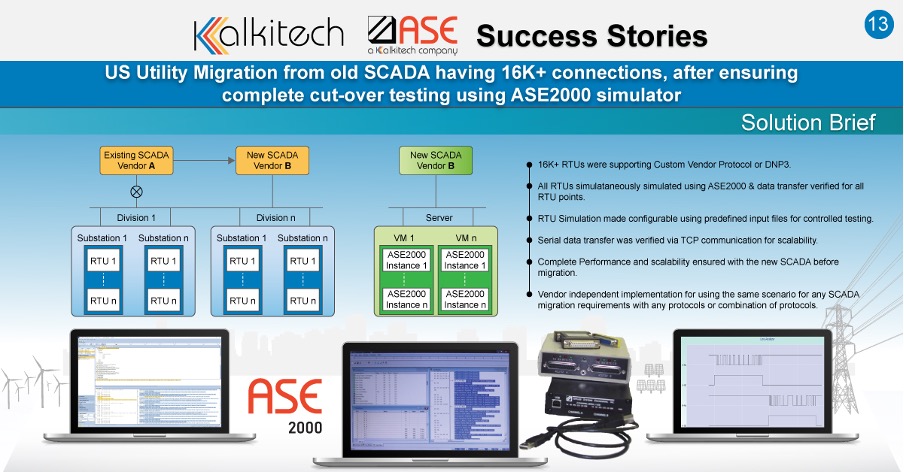US Utility migration from old SCADA having 16K+ connections, after ensuring complete cut-over testing using ASE2000 simulator
Kalkitech December 25, 2023

Kalkitech December 25, 2023

Customer: American Investor-Owned Utility (IOU) providing gas and electricity
Industry: Electric Utility
Scale: Testing needed for the 16K+ connections to ensure the migration
Business Case:
The US utility / IOU, one of the largest in the USA combining Electric and gas utilities, among the top 100 global clean energy providers, wanted to do SCADA cut-over, do migration from the existing SCADA system communicating with close to 20,000 RTUs. The protocol used for communication between SCADA and RTUs was either DNP3 and a custom Utility specific protocol. The customer wanted to test all the connections and data points of RTUs with the new SCADA virtually before going live with the real RTUs. This would ensure smooth migration with the new SCADA connected to the real RTUs. Following were the key requirements
The Solution:
For lab testing the new SCADA, entire close to 20,000 RTUs should be simulated in the lab environment with the corresponding protocol and data. The SCADA should also be for all the communication, data acquisition, and execution of the commands. The simulation of all the scenarios was done using the ASE2000 protocol simulator with corresponding nodes simulated as DNP3 / custom utility protocol. The following were the key points of the simulation environment.
Key Benefits:
Scalability & Repeatability:
The solution offered is scalable to any level. This solution is completely repeatable with any protocol combinations and can be adapted to any similar requirements.

July 25, 2025
The world energy scene is being revolutionized by the fast-paced increase of decentralized renewable energy sources like rooftop solar, wind microturbines, and energy storage in batteries. batteries. The driving force…
Know More
July 25, 2025
Smart metering has evolved significantly over the last two decades as it became a building block of modern energy management solutions. At the core of the evolution is the DLMS/COSEM…
Know More
July 25, 2025
As the energy sector undergoes rapid digital transformation, smart metering has emerged as a foundational technology in modern utility networks. By enabling real-time monitoring, automated billing, and remote disconnection, smart…
Know More